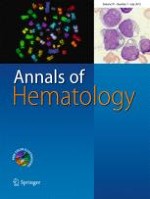Erschienen in:

01.07.2012 | Original Article
Monoallelic CEBPA mutations in normal karyotype acute myeloid leukemia: independent favorable prognostic factor within NPM1 mutated patients
verfasst von:
Annika Dufour, Friederike Schneider, Eva Hoster, Tobias Benthaus, Bianka Ksienzyk, Stephanie Schneider, Purvi M. Kakadia, Maria-Cristina Sauerland, Wolfgang E. Berdel, Thomas Büchner, Bernhard Wörmann, Jan Braess, Marion Subklewe, Wolfgang Hiddemann, Stefan K. Bohlander, Karsten Spiekermann, for the AML CG study group
Erschienen in:
Annals of Hematology
|
Ausgabe 7/2012
Einloggen, um Zugang zu erhalten
Abstract
We and others have shown that cytogenetically normal (CN)-AML patients with biallelic CEBPA gene mutations (biCEBPA) represent a molecularly distinct group with a favorable prognosis. Patients carrying a monoallelic CEBPA mutation (moCEBPA), however, show no different outcome compared to patients with wildtype CEBPA, and these mutations are frequently associated with mutated NPM1 or FLT3-ITD. So far, no molecular or clinical hallmark has been identified to prognostically distinguish moCEBPA patients from patients with wildtype CEBPA. Therefore, we used the data of 663 CN-AML patients treated within the AMLCG 1999 trial to explore the prognostic value of moCEBPA in the context of concomitant clinical and molecular markers (mutated NPM1, FLT3-ITD). Multiple Cox regression in 515 patients adjusting for all available potential confounders revealed that the NPM1 mutation modified the prognostic value of moCEBPA with respect to overall survival (OS, p = 0.017) and event-free survival (EFS, p = 0.011). MoCEBPA was beneficial in NPM1 mutated patients: adjusted OS–hazard ratio (HR) 0.09, 95% confidence interval (CI) 0.01–0.63, p = 0.016; EFS–HR (95% CI) 0.16 (0.04–0.65), p = 0.010. In contrast, moCEBPA had no prognostic impact in patients with wildtype NPM1: OS–HR (95% CI) 1.08 (0.59–1.97), p = 0.804; EFS–HR (95% CI) 1.12 (0.64–1.96), p = 0.682. We found no prognostic effect modification for moCEBPA by FLT3-ITD. The presence of a moCEBPA mutation was shown to be associated with prolonged survival in NPM1 mutated CN-AML patients. Confirmation of these results in larger studies will clarify whether an additional moCEBPA mutation influences the risk stratification of patients with an NPM1 mutated/FLT3-ITD positive genotype.











